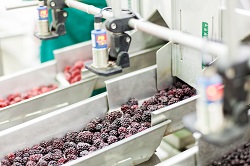New sensory tool gives industry food for thought
The EU-funded MUSE-TECH project has developed an innovative new system to monitor industrial food processing in real time by combining three different sensors into one easy-to-use tool. Positive test results suggest that the device could help food makers across a number of sectors to achieve greater processing efficiencies and ensure high standards of safety. The starting point of this three year project, which began in October 2013, was to find ways of helping the food industry to move on from conventional process control strategies – where food is only tested at the end of the process, and batch failures and reworks are frequent – to more predictive process control. This is where in-process raw materials can be checked in real time and any compositional variations or problems dealt with during manufacturing. The project team found that one effective way of achieving in-process control was to integrate three novel sensors into what is called a Multi Sensor Device (MSD). The MSD is based on a flexible plug-in architecture, allowing additional inputs from other sensors already installed in the process lines. These MSD devices were built and then tested at both pilot plant and industrial level in three case studies: bread production, fried potato chips and beer production. The first technology – Distributed Temperature Sensing (DTS) – proved robust for all three case studies, allowing accurate monitoring of complex temperature profiles under harsh environments such as during dough fermentation. The second sensor, Quasi Imaging Visible-Near Infrared (QIVN), successfully gathered data simultaneously from different points of the process. Finally, a Photoacoustic Spectroscopy (PAS) sensor was shown to be capable of simultaneously monitoring CO2, ethanol and humidity during baking. Raw data gathered by the MSD was then processed in real time using new statistical tools, and made available to end users via an easy to use interface. The project team investigated suitable communication systems and software, which were then implemented to support the integration of the MSD. The team behind the MUSE-TECH project, which has just been completed, are confident that their MSD tool will help to meet growing demand from businesses, policy makers and consumers for increased transparency along the global food supply chain. Consumers want to know where their food comes from and how it has been processed. For food makers, a problem somewhere along this chain – a batch of poor quality ingredients or contamination by unauthorised compounds for example – can shut down production and lead to significant losses unless it is dealt with efficiently and effectively. The success of the project also highlights the market potential that exists in the food sector for sensory technology developers. There is also an opportunity for food process equipment manufacturers to design and commercialise innovative equipment with tailored MSDs installed to monitor and control the specific food processes. Further research and development is now needed to develop a commercially viable MSD, with a particular focus on the design of robust and efficient probes to monitor dough during mixing and improving the PAS sensor for frying and beer production. For further information, please visit: www.musetech.eu (MUSE-TECH project website)
Countries
Spain



